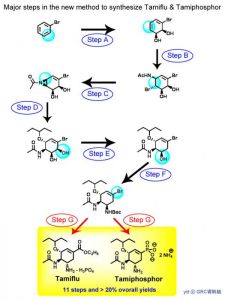Ever since the first highly pathogenic H5N1 virus was isolated in 1996, human cases of avian influenza have been reported throughout the world. Threats of avian flu were reported in Southeast China, Hongkong and Pakistan just this past month.
Researchers from The Genomics Research Center (GRC) of Academia Sinica in Taiwan made a report of their anti-influenza drug candidate named “Tamiphosphor” in September 2007. The team has been working on the improvement of procedures and effectiveness of this compound. The results of their work has been recognized by the internationally renowned chemical journal “Angewandte Chemie” editorial group and recommended as a “Hot Paper” for a timely publication. Authors of this publication include Dr. Jiun-Jie Shie (GRC Post doctoral researcher), Dr. Jim-Min Fang (Professor of National Taiwan University and GRC Joint Researcher), and Dr. Chi-Huey Wong (President of Academia Sinica and GRC Researcher).
Tamiflu is an orally available anti-H5N1/H1N1 drug to date. Drug resistance will be inevitable. Tamiphosphor functions as an inhibitor toward the neuraminidase active site of the virus, so does Tamiflu. Yet, Tamiphosphor proves to be more effective due to its higher affinity in the enzyme inhibition. Survival rate of infected mice treated with Tamiphosphor as well as symptoms of recovery all showed better result. Therefore, it possesses great potential as an oral anti-influenza drug.
“The manufacture of Tamiflu by Roche Company starts with extracting shikimic acid from anise, which is a natural herb. Getting stable quality of pure shikimic acid may be problematic.”, claimed Fang. “Another drawback of the large-scale synthesis lies in the manipulation of the potentially explosive azide reagent and intermediates.” It is known that several labs have already reported new methods in making Tamiflu without shikimic acid, but not Tamiphosphor.
|
“The first generation of Tamiphosphor synthesis took us one and half month, while the new approach has 8 fewer steps and took us only 2 weeks to complete.” noted Shie. With this new method, the total yield increased twice and since several intermediates are crystalline, it is possible to avoid chromatographic steps, and thus makes the process much easier and economic. In addition, there is no concern for lack of raw material, or any dangerous explosives in this synthetic route that is advantageous to make Tamiflu and Tamiphosphor.
Recalling the SARS experience that made local scientists realize the reality of epidemics, the team has taken the responsibilities to prevent as well as conquer the airborne H5N1 infections with no doubt. They have been working with local organizations to materialize the research accomplishment, including mass production, toxicology tests, and preclinical pharmacokinetic studies. It is a long journey as far as drug discovery is concerned, but they feel they are moving forward steadily and surely.(Early view in Angewandte Chemie, http://www3.interscience.wiley.com/journal/26737/home/2002_hotpaper.html)


